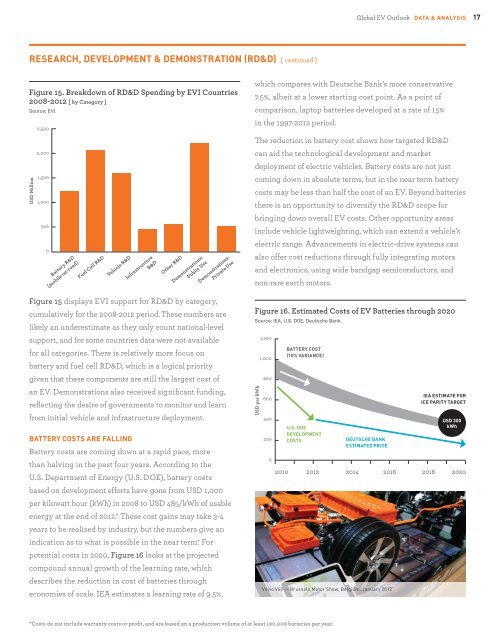Understanding the Electric Vehicle Landscape to 2020 - IEA
Understanding the Electric Vehicle Landscape to 2020 - IEA
Understanding the Electric Vehicle Landscape to 2020 - IEA
You also want an ePaper? Increase the reach of your titles
YUMPU automatically turns print PDFs into web optimized ePapers that Google loves.
Global EV Outlook DATA & ANALYSIS 17<br />
RESEARCH, DEVELOPMENT & DEMONSTRATION (RD&D) [ continued ]<br />
Figure 15. Breakdown of RD&D Spending by EVI Countries<br />
2008-2012 [ by Category ]<br />
Source: EVI.<br />
USD Million<br />
2,500<br />
2,000<br />
1,500<br />
1,000<br />
500<br />
0<br />
Battery R&D<br />
(mobile on-road)<br />
Fuel Cell R&D<br />
<strong>Vehicle</strong> R&D<br />
Figure 15 displays EVI support for RD&D by category,<br />
cumulatively for <strong>the</strong> 2008-2012 period. These numbers are<br />
likely an underestimate as <strong>the</strong>y only count national-level<br />
support, and for some countries data were not available<br />
for all categories. There is relatively more focus on<br />
battery and fuel cell RD&D, which is a logical priority<br />
given that <strong>the</strong>se components are still <strong>the</strong> largest cost of<br />
an EV. Demonstrations also received significant funding,<br />
reflecting <strong>the</strong> desire of governments <strong>to</strong> moni<strong>to</strong>r and learn<br />
from initial vehicle and infrastructure deployment.<br />
BATTERY COSTS ARE FALLING<br />
Infrastructure<br />
R&D<br />
O<strong>the</strong>r R&D<br />
Demonstrations:<br />
Public Use<br />
Battery costs are coming down at a rapid pace, more<br />
than halving in <strong>the</strong> past four years. According <strong>to</strong> <strong>the</strong><br />
U.S. Department of Energy (U.S. DOE), battery costs<br />
based on development efforts have gone from USD 1,000<br />
per kilowatt hour (kWh) in 2008 <strong>to</strong> USD 485/kWh of usable<br />
energy at <strong>the</strong> end of 2012. 8 These cost gains may take 3-4<br />
years <strong>to</strong> be realised by industry, but <strong>the</strong> numbers give an<br />
indication as <strong>to</strong> what is possible in <strong>the</strong> near term.* For<br />
potential costs in <strong>2020</strong>, Figure 16 looks at <strong>the</strong> projected<br />
compound annual growth of <strong>the</strong> learning rate, which<br />
describes <strong>the</strong> reduction in cost of batteries through<br />
Demonstrations:<br />
Private Use<br />
economies of scale. <strong>IEA</strong> estimates a learning rate of 9.5%,<br />
which compares with Deutsche Bank’s more conservative<br />
7.5%, albeit at a lower starting cost point. As a point of<br />
comparison, lap<strong>to</strong>p batteries developed at a rate of 15%<br />
in <strong>the</strong> 1997-2012 period.<br />
The reduction in battery cost shows how targeted RD&D<br />
can aid <strong>the</strong> technological development and market<br />
deployment of electric vehicles. Battery costs are not just<br />
coming down in absolute terms, but in <strong>the</strong> near term battery<br />
costs may be less than half <strong>the</strong> cost of an EV. Beyond batteries<br />
<strong>the</strong>re is an opportunity <strong>to</strong> diversify <strong>the</strong> RD&D scope for<br />
bringing down overall EV costs. O<strong>the</strong>r opportunity areas<br />
include vehicle lightweighting, which can extend a vehicle’s<br />
electric range. Advancements in electric-drive systems can<br />
also offer cost reductions through fully integrating mo<strong>to</strong>rs<br />
and electronics, using wide bandgap semiconduc<strong>to</strong>rs, and<br />
non-rare earth mo<strong>to</strong>rs.<br />
Figure 16. Estimated Costs of EV Batteries through <strong>2020</strong><br />
Source: <strong>IEA</strong>, U.S. DOE, Deutsche Bank.<br />
USD per kWh<br />
1,200<br />
1,000<br />
800<br />
600<br />
400<br />
200<br />
0<br />
BATTERY COST<br />
(10% VARIANCE)<br />
U.S. DOE<br />
DEVELOPMENT<br />
COSTS<br />
DEUTSCHE BANK<br />
ESTIMATED PRICE<br />
2010 2012 2014 2016 2018 <strong>2020</strong><br />
Volvo V60 — Brussels Mo<strong>to</strong>r Show, Belgium, January 2012<br />
<strong>IEA</strong> ESTIMATE FOR<br />
ICE PARITY TARGET<br />
USD 300<br />
kWh<br />
*Costs do not include warranty costs or profit, and are based on a production volume of at least 100,000 batteries per year.
















